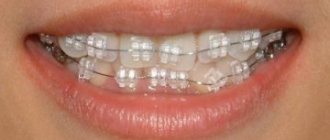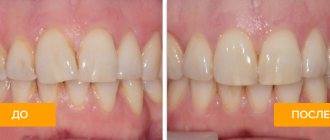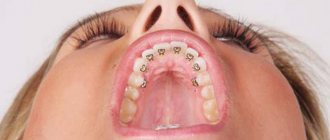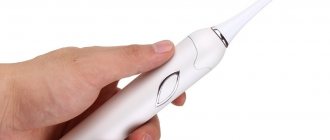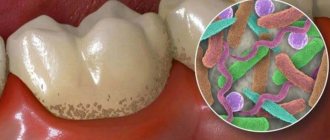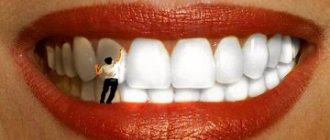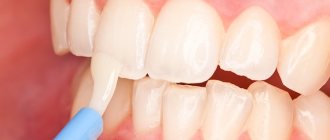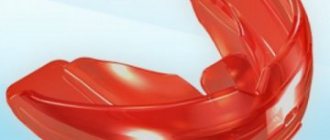One of the main ways to correct bites in adults today is vestibular, or external braces. And in everyday life we simply call them in one word - “braces”. They are fixed on the outer surface of the teeth and all the surrounding structures on the teeth are visible when the patient smiles. Something like this (see photo)
You can discuss the pros and cons for as long as you like, since they have their own advantages and disadvantages, like any bite correction system. But there are several main points. And you need to know them.
There are four advantages of external braces when correcting malocclusion:
- Firstly
, today vestibular braces are the most functional device that orthodontists can use in adults. - Second plus
. Treatment with braces really gives a fairly quick visual effect. - Thirdly
, external braces provide probably the greatest expansion. - The fourth plus
is that in terms of cost, they are probably one of the most affordable options for correcting a bite, which is important for adults.
The disadvantages are that, no matter what kind of braces orthodontists choose - metal or so-called aesthetic (transparent), ceramic, sapphire - when correcting a bite, the disadvantages are the following.
Disadvantages of external braces when correcting bites in adults:
- Firstly
, any external braces are still visible, and this very often influences the choice by adults of one or another method of treating malocclusion.
- Second minus
. In addition, of course, they contribute to the accumulation of plaque, which means hygiene is significantly reduced. And the accumulation of plaque leads to tooth decay. Therefore, you have to carefully clean your teeth and braces using special brushes. This is really tiring and it is never possible to completely clear the plaque (if you also violate your diet - see the fourth minus)
- The third disadvantage
: braces really rub the mucous membrane, especially at first they can strongly rub the mucous membrane of the cheeks and lips.
- Fourthly
, external braces also impose restrictions on the intake of hard foods, be it meat, apples, and so on.
- Fifth minus
. From the point of view of psychological comfort, vestibular braces are also, of course, constraining.
Pros and cons of braces according to doctors' reviews
Real reviews from doctors about the pros and cons of braces boil down to the fact that the main advantage of these devices is their ability to correct even the most complex malocclusions, unlike other orthodontic devices, and the disadvantage is the difficulty of care and aesthetic qualities (with the exception of certain types of braces) . In addition, experts do not advise choosing braces based on numerous tables on the Internet, which compare treatment periods for different types of braces and prices for these designs. Why?
Firstly, every patient must understand that the degree of impact on the teeth and the duration of the correction process are the same for all braces. This is due to the natural mechanism of tooth movement. Secondly, the following can be said about the cost of braces. There are clinics that offer expensive sapphire braces for the price of ceramic ones. And it's not a joke. It’s just that the cost of orthodontic structures and services for their use depends on the pricing policy of dentistry, and not on the quality of braces or the qualifications of the doctor. Therefore, in our article we will, of course, talk about approximate prices for this or that type of braces, but, basically, we will evaluate bracket systems according to the following criteria:
- aesthetics;
- reliability;
- comfort of wearing;
- ease of care.
Interesting fact!
According to rumors, scientists at Oxford University are working on creating magnetic braces. They say that the principle of their operation will be based on the creation of a constant magnetic field using two miniature generators, which will act on the iron contained in the teeth and effectively correct the bite without the need to wear any structures.
Sixth, intimate minus
We specifically highlighted this minus as a separate item. Doctors tactfully remain silent about this drawback of any brace systems, including lingual ones. But it exists. And it causes a lot of problems for their owners. This is injury, but not to the tongue, but injury to parts of the mucous membrane of the sexual partner during intimate caresses: causing micro-scratches with possible infection of the wounds due to insufficient hygiene of braces.
Such statistics are periodically published in the European and American press, where they really and openly talk about it. With aligners, this problem is absent or minimized: we always try to brush our teeth normally, but with braces it becomes increasingly more difficult to clean. And remember that you will live with this problem side by side for the entire duration of treatment - from a year to 3 years. It suits you?
Type of braces
Ligature braces
- the elasticity of the ligatures ensures more comfortable wearing of braces.
- affordable price.
- It is necessary to change the ligatures regularly (about once a month), as they stretch while wearing braces.
- a more complex hygiene procedure due to the presence of ligatures.
Braces without ligatures
- There is no need to replace ligatures, so you can visit the doctor less often.
- Easier oral care routine.
- are more expensive than ligature braces.
Advantages of aligners over braces
The two main advantages - aesthetics and wearing comfort - are due to the design of this product. This allows you not to experience embarrassment during treatment, as happens when wearing braces, when a person is embarrassed to smile and talk, experiencing stress and becoming withdrawn, refusing to communicate. Aligners eliminate such problems - they make you look the same as usual, and in extreme cases they can be removed altogether.
Aligners are more effective than braces in another respect: there are almost no restrictions on food intake. Even solid foods can be eaten if they are removed before meals. It is impossible to remove the braces for a while, so you will have to eat in them, which means you will have to give up solid food, which can break the structure, and after eating, rinse your mouth thoroughly and brush your teeth using special brushes and toothpicks, since food gets stuck between them much more strongly. teeth.
Well, difficulties in oral hygiene will result in the development of caries if the patient allows himself to relax and not be too diligent in caring for the oral cavity. When using aligners, such problems do not arise, you can eat and brush your teeth as usual.
Finally, what makes you choose aligners instead of braces is their purely medical effectiveness - treatment with aligners is faster, and you can change the aligners yourself if necessary. Aligners cover the teeth more tightly and transfer the load to them more evenly, allowing them to be moved in several axes at once, which speeds up treatment and at the same time makes it safer and more comfortable.
Ceramic braces - pros and cons
These orthodontic systems are made from dental ceramics. Having analyzed the pros and cons of non-ligature and ligature ceramic braces, we can conclude that such brace systems represent good value for money, allowing you to solve any bite problems at an affordable price, which in Moscow clinics is about 30,000 rubles for the design itself. one row of teeth. In this case, diagnostics, installation and removal of the system will have to be paid additionally.
Diet
While wearing ceramic braces, a person should review their diet and limit the consumption of certain foods. Due to the fact that ceramics is a fairly fragile material, you should not put a sharp load on the structure and eat hard foods - these include nuts, crackers, apples. This food can cause the braces to break and come off.
It is advisable to cross off food that stretches and can stick to the surface of your teeth from your shopping list. Toffees, some candies, chewing gum, fresh flour products, dried fruits, corn flakes, chips can remain in the spaces between the components of the structure, increasing the risk of pathogenic bacteria joining and the development of a pathological process. Also, these products can dislodge the structure, which will be an important reason for going to the dental office.
Sweets and foods high in carbohydrates are temporarily excluded from the diet - their fragments can remain between the elements of braces and tooth enamel, increasing the risk of plaque, tartar and carious lesions.
Whether it is possible to drink coffee drinks while wearing ceramic braces is a controversial issue. It is believed that ceramics are resistant to food dyes, but in the absence of high-quality oral hygiene, the accumulation of pieces of food in the teeth, the resulting plaque can absorb pigments and thereby affect the change in shade of the structure. The same goes for smoking. This is not prohibited, but it is advisable to minimize such exposure.
You should not eat too hot or too cold food - firstly, this negatively affects the enamel of the teeth, and secondly, it can lead to loss of structure properties.
After installing the brace system, it is recommended to eat food that contains large amounts of magnesium, calcium, vitamins A, B, C, D, fruits and vegetables, soups, purees, and dairy products.
Sapphire braces - pros and cons
These are transparent braces made from artificial sapphire, which really do not spoil the patient’s appearance, but look like a stylish accessory. As for the pros and cons of sapphire braces, their main advantage is considered to be high aesthetics, and a significant disadvantage is the price, since most often they cost much more than ceramic ones. However, there are cheaper options for sapphire designs combined with metal or ceramic. Thus, the cost of braces made entirely of sapphire starts in Moscow clinics from 70,000 rubles per design for one row of teeth.
Popular myths
1. It's not nice. There is a myth that fixed appliances do not look very aesthetically pleasing, and the person wearing them cannot look attractive. But modern braces do not affect the aesthetics of a smile. Firstly, there are lingual braces that are completely invisible to others. Secondly, even external braces can be beautiful: sapphire, ceramic, and plastic structures can even add a certain charm to your smile.
2. Braces are only for children. Many patients still have associations with braces - teenage schoolchildren. But it has no basis. Children and adolescents have more options and correction methods, and removable orthodontic appliances are more often used. Adults with a mature dental system have fewer options - braces are used more often as a powerful tool. It is worth noting that there are no upper age restrictions for braces - they are successfully used at both 25 and 60 years old. The older the patient, the longer the retention period, that is, the result will have to be consolidated longer, and this is the only age difference;
3. It hurts. This myth has a reasonable explanation; indeed, pain and discomfort do occur, but not all the time. It may be painful the first few days after installation. This is a normal symptom that occurs as a result of pressure on the teeth. Most patients report moderate pain and itching in the gums, which go away on their own and do not require correction with medications. But everyone has their own pain threshold and perception of pain, so the doctor will tell you how to get rid of unpleasant sensations.
4. It's harmful. It is believed that the non-removable structure destroys the teeth. But preliminary diagnosis is needed in order to assess the strength of the enamel and the risks of complications. Normal enamel can withstand the structure, and compliance with hygiene and doctor’s recommendations eliminates the risk of developing caries in areas of the teeth near braces.
Type of braces
Lingual
- completely invisible.
- as durable as metal systems.
- are more expensive than ceramic braces.
- They are more difficult to maintain than labial systems, which are attached to the outside of the teeth.
- significantly affect diction.
Of course, the above pros and cons of braces will play an important role in shaping your preferences regarding one or another type of these orthodontic structures. However, we will tell you a secret: the best braces for each patient will be those that will help him solve his particular bite problems. Therefore, an experienced and knowledgeable orthodontist will help you choose the right bracket system after examining and diagnosing your teeth.
What lengths do aligner manufacturers now go to in order to divert patients' attention from braces?
There are good discounts, free consultations, and even free modeling of a future smooth and beautiful smile. But most people, out of established habit, still choose braces as the main way to correct their bite. In any case, whichever method you choose now, this is the first step towards solving the problem of crooked teeth and entering a new world of opportunities that will open up your beautiful smile. And by the way, you can sign up for a free consultation and 3D smile modeling in your city by filling out the form below this article. Star Smile specialists will select a specialized orthodontic center for you in close proximity to your residence. By the way
, you can find out in 1 minute whether aligners are right for you at all or whether doctors will forcefully offer only braces: you need to answer only
9 express questions
.
Active and passive self-ligation
Self-ligation can be passive or active. With the active type of fixation, the bracket clip applies pressure and moves the archwire towards the base of the slot. The orthodontic arch, in turn, puts pressure on the clip. In the case of passive self-ligation, the cover fixes the archwire in the slot without exerting pressure on it. When closed, the bracket turns into a buccal tube: the static cover becomes the fourth wall of the groove, the arch moves freely and is not subject to force. Example: Damon Q.
Damon Q with orthodontic arch
Which braces are best for adults and pediatric patients? American orthodontist Vourdouris JC compared the frictional force of the arch in the bracket groove when using passive and active non-ligature structures. According to a study published in the American J. of Orthodontics & Dentofacial orthopedics, active systems operate with a high friction force of 31.0 g, while passive designs have a low friction force of 0.1 to 0.18 g.
The data obtained scientifically prove that passive self-ligating systems are able to interact with archwires throughout treatment without loss of force and provide a new standard of low friction when moving teeth. American scientists Thorstenson GA and Kusy supplemented the results of the study. Experts have found that when using the Damon System passive self-ligating system, there is significantly lower frictional resistance in dry and wet environments compared to active structures.
Studies conducted by orthodontists indicate the benefits of treatment with passive self-ligating braces.
Second factor: cost
If the choice of braces is determined not by the doctor, but by the clinic, then the clinic can save money. It is much more profitable to buy cheap braces, but how to work with them is a question for the orthodontist. More effective and technologically advanced brace systems are already slightly higher in cost due to the fact that scientific developments, a huge number of studies, and articles have been invested in them. And the bracket becomes a tiny orthodontic mechanism, into which a large technological base is invested. The cost of such a product cannot, in principle, be cheap. An analogy can be drawn with untested dietary supplements and medications that have undergone many certifications. Therefore, at the Confidence aesthetic orthodontics clinic, we work with braces produced by Ormco and 3M Unitek - these are truly first-class and proven products. They carry two categories of advantages - both for the doctor and for the patient.
Advantages for the patient: treatment time is reduced, it can be treated without removal, in cases that previously could not be treated in this way, these braces are small, comfortable, and due to self-ligation, the patient can visit the doctor less often. Pros for the orthodontist: more complex cases can be treated faster, more comfortably, this is an amazing compromise of quality, time and finances. The most ideal compromise.
Adaptation period
Getting used to the orthodontic appliance takes about 2 weeks. Patients adapt to aligners more easily and quickly than to braces. This is due to the fact that mouthguards for straightening teeth can be removed independently, the elastic material does not injure the soft tissue, and due to the precise fit of the structure, sound pronunciation is not disturbed.
It is more difficult to get used to braces due to their design features. In addition, the first days of treatment are accompanied by pain. But in any case, adaptation to the corrective apparatus does not take more than 10-14 days.
Indications and contraindications
There are many indications for installing braces. They are effective for varying degrees of complexity of curvatures: with slight crowding or, conversely, sparseness of the row, underdeveloped jaws, incorrect position of one or more units in the row, the presence of gaps between the teeth and mild bite pathologies.
Orthodontic treatment also has contraindications: serious chronic diseases, HIV, diabetes, oncology, disruption of the immune system, problems with bones and joints, allergic reactions to the materials used, etc. The possibility of installing braces should be judged by a qualified physician and only on the basis of a thorough preliminary examination of the patient.
The most suitable age to begin correction is considered to be 12-13 years old. At this time, the formation of the bite has not yet been completed, so it is much easier to correct it. The older the person, the longer the period for correcting the defect will be. This is why it is so important that parents seek help from an orthodontist when the first alarming symptoms appear.
Restoring enamel after braces
The aesthetic consequences of braces can be successfully eliminated using the following procedures:
- professional cleaning;
- teeth whitening;
- installation of retainers with a special composition that strengthens the enamel;
- polishing and processing of enamel with special solutions.
Features of care
Hygienic care of the aligners does not require much effort. It is enough to wash the structure with water 2 times a day, clean it with a brush and treat it with an antiseptic solution. When eating or drinking coloring drinks, the mouth guard is removed and placed in a box. The patient wears one pair of aligners for 2-3 weeks, so the system does not have time to become heavily contaminated.
Hygiene with braces installed is more complex and requires a systematic, careful approach. Additional tools will be required for cleaning:
- Orthodontic, mono-beam brush;
- brush for cleaning hard-to-reach places, the space under the arch;
- irrigator.
You should brush your teeth and rinse your mouth every time after eating. Too hard, viscous and sticky foods should be excluded from the diet.
FAQ
How does the oval of the face change after braces?
The face after braces becomes more symmetrical and proportional. This is a consequence of correcting the bite. For example, if a patient’s teeth do not close together and the face appears elongated, then after correction with braces the cosmetic defect is eliminated. Most often, after such treatment, the cheekbones become more expressive and the cheeks become sunken.
Is it possible not to wear retainers after braces?
Can. However, the consequences of such a decision are difficult to predict. The teeth will again try to return to their previous position. And then, 1-2 years of correction with braces will be useless.
Do braces make your lips look bigger?
Visually, yes, because there is a bracket arch under the lip. However, after removing the structure, the effect of lip augmentation disappears.
Do teeth fall out from braces?
No, they don't fall out. And information about this is just rumors that have no basis.
Myth No. 5. An allergic reaction to braces is possible.
A very small percentage of patients are allergic to nickel, which is part of the alloy from which braces are made. This is not a problem. If you have any concerns, you can always conduct a preliminary allergy test and, if an allergy is detected, choose braces from a different material. If you are allergic to latex components necessary for treatment, they can be replaced with latex-free ones.
A very small percentage of patients are allergic to nickel, which is part of the alloy from which braces are made.
Which braces do men choose and which braces do women prefer?
Lingual braces are most often chosen by men in leadership positions and women who are sensitive to the aesthetics and invisibility of braces. Men respond better to Incognito internal braces because they are willing to invest in their health and smile, while keeping orthodontic treatment a secret. In addition, men are impressed by German technology and reliability.
If invisibility does not play a role, then men more often choose advanced digital technologies Insignia and braces, which, like a good suit, are made individually. Insignia is the male choice, since they are aimed at high technology, they are interested in it, they believe in it. Women for whom aesthetics and invisibility of the treatment process are especially important often choose transparent braces such as Inspire Ice (sapphire) or Clear (ceramic). In general, at Confidential we always try to find a compromise between aesthetics and functionality.
What's more aesthetically pleasing?
Aesthetics in orthodontics is the main criterion. All braces, except for lingual models, are visible to others up close. Even subtle systems made of ceramic and sapphire. The aligners are made from a transparent, elastic biopolymer, fit exactly to the teeth and are completely invisible. Visually, the appearance of a person does not change in any way.
The ease of use of corrective aligners is a definite plus. Care is not difficult in any way, there are no dietary restrictions or difficulties with hygiene - the aligners are removed when eating and brushing your teeth.
How to install braces for adults
The installation of braces follows the same scheme, regardless of the chosen system. It all starts with preparation, which takes place in several stages:
- The dentist talks with the patient, examines his teeth, and listens to his expectations from treatment.
- X-rays, computed tomography are done, and if necessary, an impression is taken. Based on this, the treatment is simulated on a computer.
- A decision is made on the material of braces based on the examination and the wishes of the patient.
- Sanitation of the oral cavity is carried out - all diseases of the gums and teeth are treated, so that in the future there will be no need to carry out treatment and remove braces for this. Professional cleaning is also required.
- If it is necessary to create free space in the jaw, individual teeth are removed - usually chewing molars.
After the teeth are completely prepared, the braces are installed directly. It goes according to the following scheme:
- The teeth are thoroughly cleaned of plaque and dried of saliva.
- The enamel is etched with a special acid. It is safe, but makes the enamel more susceptible to the adhesive.
- A small amount of adhesive glue is applied to the enamel. Some modern braces have an adhesive on the clasps themselves - in this case this step is skipped.
- Braces are attached to the teeth one at a time.
- Excess adhesive is removed so as not to create voids under the braces, and then hardens under the influence of a special lamp.
- An archwire is threaded into the braces.
At this point, the installation is considered complete, the patient is taught how to care for braces, the next follow-up appointment is scheduled, and he is sent home. The whole process takes about half an hour; in the case of lingual braces, it can take an hour.
After installation, the patient will need to visit the doctor several more times to monitor the correction of the bite and replace the arch with a less flexible one.
